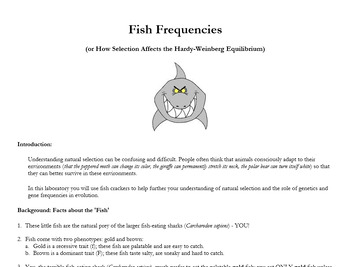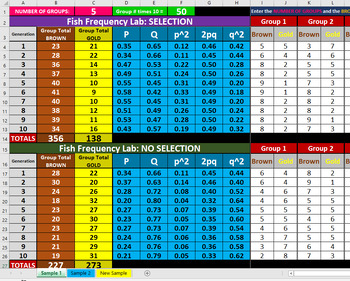Fish Frequency Lab for Hardy Weinberg Equilibrium (Handout + Spreadsheet)
Mr Biology03
7 Followers
Grade Levels
9th - 12th, Higher Education, Adult Education, Homeschool
Resource Type
Standards
NGSSHS-LS4-2
NGSSHS-LS4-1
NGSSHS-LS4-6
NGSSHS-LS4-3
NGSSHS-LS4-4
Formats Included
- Zip
Mr Biology03
7 Followers
Products in this Bundle (2)
Description
Understanding natural selection and the Hardy-Weinberg Equilibrium equation can be confusing and difficult.
Let this lab activity help clear some of the confusion for your students! In this laboratory activity, you will use fish crackers to help further your understanding of natural selection and the role of genetics and gene frequencies in evolution and natural selection.
The only supplies you need are 2 different types of fish crackers (goldfish).
This product includes a lab handout plus a companion spreadsheet that will help calculate and display class data for this lab.
Total Pages
Answer Key
N/A
Teaching Duration
45 minutes
Report this resource to TPT
Reported resources will be reviewed by our team. Report this resource to let us know if this resource violates TPT’s content guidelines.
Standards
to see state-specific standards (only available in the US).
NGSSHS-LS4-2
Construct an explanation based on evidence that the process of evolution primarily results from four factors: (1) the potential for a species to increase in number, (2) the heritable genetic variation of individuals in a species due to mutation and sexual reproduction, (3) competition for limited resources, and (4) the proliferation of those organisms that are better able to survive and reproduce in the environment. Emphasis is on using evidence to explain the influence each of the four factors has on number of organisms, behaviors, morphology, or physiology in terms of ability to compete for limited resources and subsequent survival of individuals and adaptation of species. Examples of evidence could include mathematical models such as simple distribution graphs and proportional reasoning. Assessment does not include other mechanisms of evolution, such as genetic drift, gene flow through migration, and co-evolution.
NGSSHS-LS4-1
Communicate scientific information that common ancestry and biological evolution are supported by multiple lines of empirical evidence. Emphasis is on a conceptual understanding of the role each line of evidence has relating to common ancestry and biological evolution. Examples of evidence could include similarities in DNA sequences, anatomical structures, and order of appearance of structures in embryological development.
NGSSHS-LS4-6
Create or revise a simulation to test a solution to mitigate adverse impacts of human activity on biodiversity. Emphasis is on testing solutions for a proposed problem related to threatened or endangered species, or to genetic variation of organisms for multiple species.
NGSSHS-LS4-3
Apply concepts of statistics and probability to support explanations that organisms with an advantageous heritable trait tend to increase in proportion to organisms lacking this trait. Emphasis is on analyzing shifts in numerical distribution of traits and using these shifts as evidence to support explanations. Assessment is limited to basic statistical and graphical analysis. Assessment does not include allele frequency calculations.
NGSSHS-LS4-4
Construct an explanation based on evidence for how natural selection leads to adaptation of populations. Emphasis is on using data to provide evidence for how specific biotic and abiotic differences in ecosystems (such as ranges of seasonal temperature, long-term climate change, acidity, light, geographic barriers, or evolution of other organisms) contribute to a change in gene frequency over time, leading to adaptation of populations.



